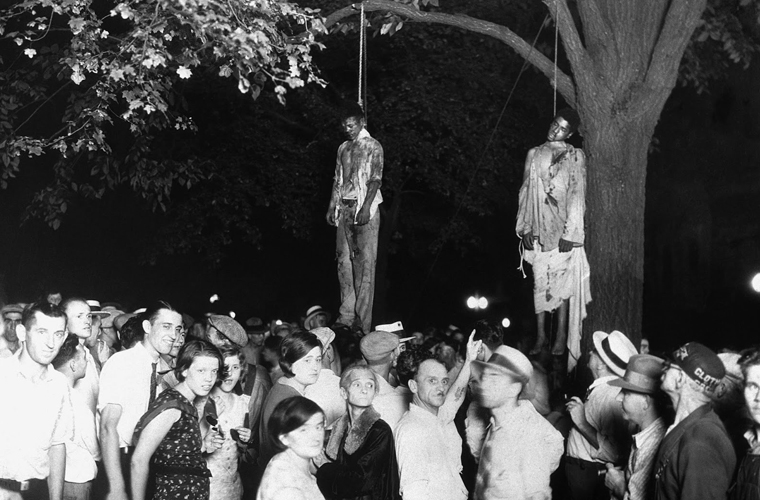On a hot August night in 1930, a crowd gathered in front of an Indiana jail — men, women, and children shouting and jeering, demanding that the sheriff release his three prisoners. Three African-American teenagers: Tom Shipp, Abe Smith, and James Cameron — huddled inside their cells, charged with the murder of a white man and the rape of a white woman.
Some among the thousands of people in front of the jail formed a mob. They beat down the jail doors, pulled the three youths from their cells, brutally beat them, and dragged them to a tree on the courthouse square. At the last minute, the mob spared Cameron, the youngest and most boyish of the trio. Smith and Shipp died, lynch ropes around their necks, their bodies hanging as the town photographer captured one of the most famous lynching photographs in American history. They weren’t even hung properly. They had a noose put around their neck and were then pulled up into the tree. And one of them tried to get free so they hauled him down, broke his arms and hauled him back up again.
The corpses hung in the square for hours, attracting crowds of gawkers — including the photographer Lawrence Beitler who was able to snap this picture. The photo sold thousands of copies, which Beitler stayed up for 10 days and nights printing them.
The third person 16-year-old James Cameron, narrowly escaped lynching thanks to an unidentified participant who announced that he had nothing to do with the rape or murder. Cameron was moved out of town, convicted as an accessory to the murder and served four years in jail. After the lynching, Cameron became a very devout man and vividly describes this day in his autobiographical account “A Time of Terror”. He became an anti-lynching activist in Indiana and, later, Wisconsin — where he founded a Black Holocaust Museum. He believed that the voice that came from the crowd to save him was the voice of an angel. Cameron died on June 11, 2006, at the age of 92.
Were they guilty? James Cameron stated in interviews that Shipp and Smith had, in fact, shot and killed Claude Deeter, a white man. Cameron claimed that he fled when he realized what was going on. So the guys are guilty of murder. The rape allegation — although it, and not the homicide, seems to have been the thing that triggered the lynching — was subsequently withdrawn. Mary Ball later testified that she had not been raped, contrary to the accusations against the three men. Back then, white women being raped by black men was worse than murder in the eyes of many.
Why there’s always at least one person in the photo pointing? The pointing is basically a threat towards other black people to stay in their place, or they will meet the same fate. Pointers are a phenomenon that exists in tons of photos with the dead, not just limited to that time period.
The picture was the inspiration for the poem “Strange Fruit” which was later put to song and popularized by the incredible Billy Holiday and became an early anthem for the burgeoning civil rights movement. Teacher/poet Abel Meeropol ran across this photo of the Shipp-Smith lynching a few years later in a magazine, and it so “haunted” him — his word — that he penned the anti-lynching poem “Strange Fruit”.
Interesting facts:
- The word lynch originated around the mid 19th century. It comes from the Lynch Law which was the practice of killing an alleged criminal by lynching. The Lynch Law, in turn, got its name from Captain Willian Lynch. He was a planter and was a self-constituted judicial tribunal in Virginia. Unofficial tribunals used to be set by him to try the suspects. This rough and ready method of giving judgment came to be known as Lynch Law. Lynch’s most favorite punishment was flogging the suspect. After being flogged or ‘lynched’ if the suspect continued to commit the same crime or violated the rules, they were hanged.
- Someone getting lynched doesn’t necessarily mean race was a factor at all. It was just “meting out punishment (often execution) outside of the court system”. In other words, “trial” by the mob. Here are some statistics about lynching by race and state, according to this records 30% of people lynched were white.
- Photographs and postcards took as souvenirs at lynchings throughout America. One surprising recent discovery that documents lynching in an incredibly impactful and disturbing way was a collection of lynching postcards. It turns out that professional photographers took photos of lynchings and sold them as postcard souvenirs to attendees; some of these postcards were then mailed with writing on the back, and eventually archivists collected them. The book Without Sanctuary, reprints both the photos and some of the text from the postcard backs; the text is just incredibly disturbing, with some writers describe the picnic or holiday atmosphere of the lynching and some just not even seem to acknowledge that they’re sending a picture of an inhuman atrocity to their loved ones.

